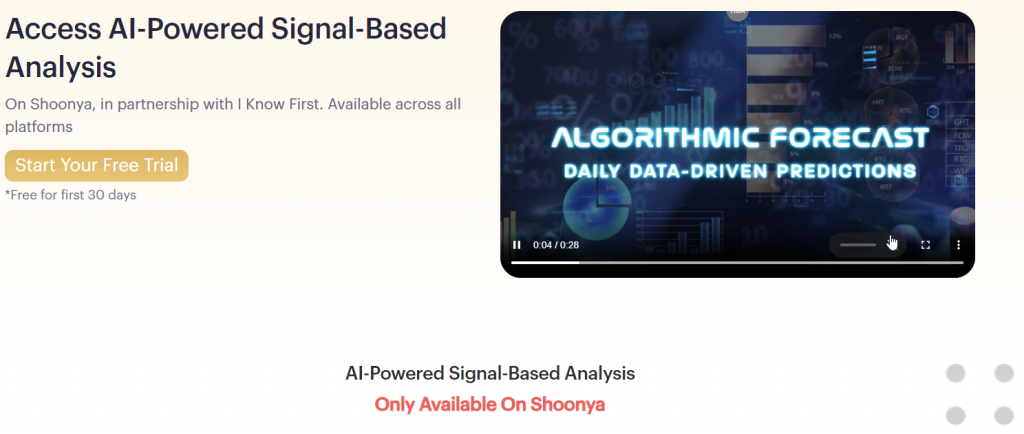To ensure that you are using a system that can provide accurate predictions and information, it is important to evaluate the accuracy and efficacy of AI platform for predicting stocks and analyzing them. Here are 10 tips to evaluate these platforms.
1. Backtesting Results
What to Look Out For Make sure the software allows backtesting. This allows you to evaluate how predictions would have performed using historical data.
Why it is Important : Backtesting can be used to validate the validity of an AI model through comparing the predictions with actual results.
Search for platforms that permit users to modify backtesting parameters, like time periods and asset classes.
2. Real-time performance tracking
What to Look Out For What the platform does in real-time situations.
Why is it important Real-time performance gives a more accurate gauge of its efficiency rather than relying on only historical backtesting.
Use a free trial or demo account to monitor and compare the accuracy of real-time forecasts to actual market movement.
3. Prediction Error Metrics
What to look for: To quantify the accuracy of your forecasts, you should evaluate measures like mean absolute error (MAE) and root mean squared error (RMSE) and R-squared.
What is the significance of these indicators are a method to measure how closely the predictions correspond to actual results.
Tip: Platforms that publicly share their data tend to be more transparent and trustworthy.
4. Win Rate and Success ratio
What to Look For Look for the platform's win rate (percentage of predictions that are correct) and the success rate (profitability of trading that are based on predictions).
What is important The high success rate and win rates indicate better precision in forecasting and a greater potential for profitability.
There is no perfect system. Beware of sites with unrealistic winning rates, e.g. 90% %+),.
5. Benchmarking Market Indices against Benchmarks
What to look for: Examine the predictions and the performance of the platform against the major market indexes.
What is important This will help to determine if a platform is over or underperforming the overall market.
Find out if the performance remains consistent over time, and not only in the short-term.
6. Congruity of Market Conditions
What to Look for Look at what the platform's performance is at different market conditions.
What is important A solid platform should perform well in all market conditions not just when the market is in good shape.
Try the platform's forecasts during periods of volatility and market crashes.
7. Transparency in Methodology
What to look for Learn about the AI algorithms and models used (e.g. neural networks or reinforcement learning).
What's important Transparency lets you examine the scientific and technological reliability of a system.
Beware of platforms that make use of models with "black boxes" that do not explain the process by which predictions are made.
8. Tests and User Reviews
What to look for: Read user reviews as well as independent tests and third-party evaluations.
Why it is Important Reviews and tests conducted by independent experts provide objective information on the accuracy and performance of the system.
Check user reviews in forums like Reddit copyright and financial blogs.
9. Risk-Adjusted Returns
What to Look for What to look for: Evaluate the platform's performance by using risk-adjusted indicators such as the Sharpe Ratio and Sortino Ratio.
What's important The numbers reflect the amount of risk required to earn returns. They give a clearer view of overall performance.
Sharpe Ratios that are higher than 1 indicate better returns, adjusted for risk.
10. Long-term Track Record
What to Look for How to evaluate the performance of the platform over time (e.g. three to five years).
Why it is Important : Long-term performances are more reliable than results in the short-term.
TIP: Avoid platforms that focus on short-term success or cherry-picked results.
Bonus Tip: Test using a Demo Account
Try out the platform with no cost demo accounts to test how precise it can be in real time. This lets you evaluate the accuracy and performance of the platform firsthand.
Use these guidelines to assess the accuracy, efficiency and reliability of AI stock prediction and analysis platforms. It is then possible to select the one that is most compatible with your trading objectives, and your level of risk. Keep in mind that no trading platform is perfect The best approach is to mix AI insights with personal study. Check out the recommended continued about ai trading platform for blog examples including ai stock picker, ai stock trading bot free, ai trading platform, best ai copyright, stock predictor, ai investing tools, trader ai intal, ai trading bots, ai for copyright trading, best ai stocks to buy and more.

Top 10 Tips For Risk Management Of Ai Trading Platforms That Can Predict Or Analyze The Price Of Stocks.
Risk management is a crucial component of any AI stock predicting/analyzing trading platform to protect your capital and reduce the risk of losses. A platform that has robust tools for managing risk can help navigate volatile markets and allow you to make educated decisions. Below are the top 10 tips to evaluate the risk management capabilities of these platforms.
1. Evaluate Stop-Loss and Take-Profit Features
Customizable levels: Ensure the platform lets you determine take-profit and stop-loss limits for individual trades or strategies.
Examine the platform to determine whether it has a trailing stop feature, which will adjust automatically when the market moves your way.
Check if your platform allows you to place stop-loss orders that ensure the close of your trade at the amount stipulated, even on unstable markets.
2. Assessment Position Sizing Instruments
Fixed amount: Ensure the platform allows you to establish the size of a position based upon an amount that is fixed in monetary terms.
Percentage portfolio: Find out whether the risk can be controlled proportionally by setting your positions according to percent of your portfolio's total.
Risk-reward-ratio: Determine if the platform permits users to define their own risk/reward ratios.
3. Look for Diversification support
Multi-asset trading: Make sure the platform allows you to trade across a variety of types of assets, including ETFs, stocks as well as options. This will help diversify your portfolio.
Sector allocation: Check whether the platform provides tools to monitor and manage the exposure of sectors.
Diversification of geographic areas. Check if the platform can trade internationally and spread geographic risks.
4. Review the margin and leverage controls
Margin requirements. Be sure to know the margin requirements before trading.
Find out if your platform lets you to limit leverage to limit risk exposure.
Margin Calls: Verify that the platform sends out timely notifications of margin calls in order to avoid liquidation of your account.
5. Assessment Risk Analytics and reporting
Risk metrics: Make sure the platform offers the most important risk metrics to your portfolio (e.g. Value at Risk (VaR) Sharpe ratio, and drawdown).
Analysis of scenarios: Make sure that the platform enables you to test different scenarios of the market in order to evaluate the risks.
Performance reports: See whether the platform provides specific performance reports with risk-adjusted return.
6. Check for Real-Time Risk Monitoring
Portfolio monitoring: Ensure the platform offers live monitoring of the risk exposure to your portfolio.
Alerts: Make sure you can receive real-time notifications for risk related (e.g. stop-loss triggers and breach of margins).
Check for customizable dashboards that provide a comprehensive overview of your risk profile.
7. Evaluation of Stress Testing and Backtesting
Stress testing. Make sure your platform allows you to stress test the portfolio or strategy in extreme market conditions.
Backtesting - Check to see whether your platform permits you to test strategies back using previous information. This is an excellent way to measure the risk and evaluate performance.
Monte Carlo Simulators: Verify whether the software uses Monte Carlo models to model possible outcomes and evaluate risks.
8. Risk Management Regulations Compliance Assessment
Compliance with Regulations: Check the compliance of the platform with applicable Risk Management Regulations (e.g. MiFID II for Europe, Reg T for the U.S.).
Best execution: Ensure that the platform follows the best execution methods. This will ensure that trades are executed according to the highest price possible in order to reduce loss.
Transparency: Check to see whether the platform is able to disclose risks in a clear, transparent manner.
9. Examine for Risks that are User Controlled Parameters
Custom risk management rules: Ensure the platform you select lets you create your own custom risk management rules.
Automated risk control: Determine whether the platform can automatically apply rules to manage risk based on your defined parameters.
Manual overrides: Make sure that the platform supports manual overrides during emergency situations.
Reviews of User Feedback and Case Studies
User reviews: Study user feedback and analyze the effectiveness of the platform's managing risk.
Case studies and testimonials The case studies and testimonials will demonstrate the capabilities of the platform for managing risk.
Community forums: Check if the platform has an active user community in which traders can share tips for managing risk and strategies.
Bonus Tips
Trial period: You can make use of a demo or a no-cost trial to experience the risk management features of the platform.
Customer support - Ensure that the platform offers a robust assistance for any questions or issues relating to risk.
Educational sources: Find out if your platform offers educational materials or tutorials that explain risk management practices.
By following these tips you can determine the capabilities of an AI software for analyzing and predicting stocks to control risks. This will ensure you pick a system that is safe for your investment and reduces the possibility of losses. For trading success and to navigate volatile markets, robust risk management tools are vital. Take a look at the recommended here are the findings for ai trading software for blog tips including ai for stock trading, best free copyright trading bot, ai trading tools, ai stock trader, trade ai, best ai stocks to invest in, ai stock price prediction, ai copyright trading bot, best ai copyright, ai for investing and more.
